Comprehensive Evaluation: Supplemental Nutrition Assistance Program
VerifiedAdded on 2023/04/24
|8
|1941
|237
Report
AI Summary
This report provides a comprehensive evaluation of the Supplemental Nutrition Assistance Program (SNAP), a federal initiative aimed at addressing food insecurity and improving the nutritional well-being of low-income families in the United States. It highlights the program's goals, including reducing hunger, promoting better health outcomes, and lowering healthcare costs. The report discusses the historical evolution of SNAP, its alignment with nutritional guidelines, and the introduction of quality control measures. It also examines the positive impacts of SNAP, such as reducing food insecurity and improving long-term health. The report identifies key stakeholders involved in SNAP, including government agencies, policymakers, retailers, and advocacy groups, and analyzes conflicts among them, particularly regarding restrictions on eligible food purchases. It concludes by emphasizing the need for aligning SNAP benefits with nutritional science and ensuring that the program effectively serves the health needs of low-income populations. Desklib offers a wealth of resources, including solved assignments and past papers, to aid students in understanding complex topics like program evaluation and nutrition assistance programs.
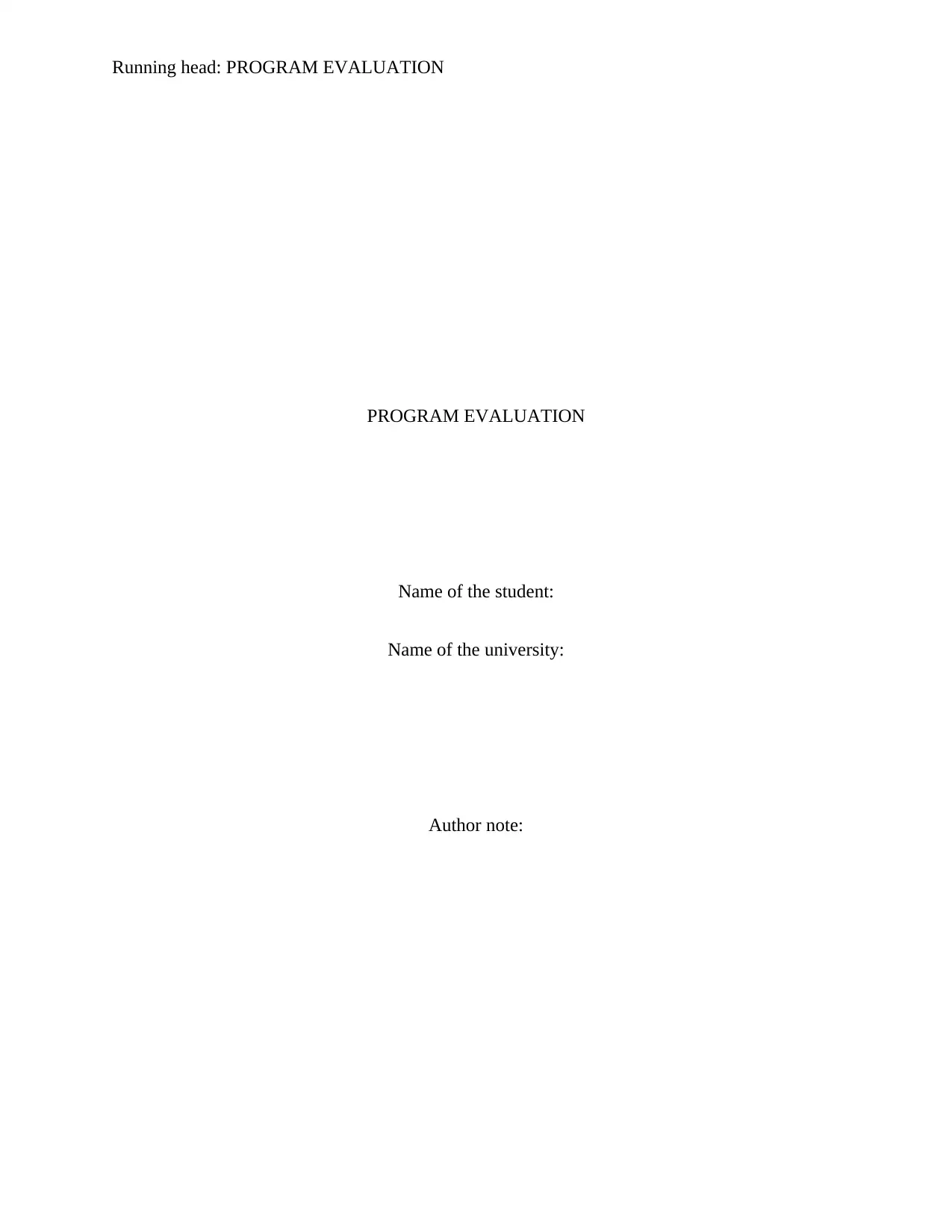
Running head: PROGRAM EVALUATION
PROGRAM EVALUATION
Name of the student:
Name of the university:
Author note:
PROGRAM EVALUATION
Name of the student:
Name of the university:
Author note:
Paraphrase This Document
Need a fresh take? Get an instant paraphrase of this document with our AI Paraphraser

1
PROGRAM EVALUATION
SNAP or supplemental Nutrition Assistance Program is a federal program that helps
millions of low income families Australia meet their basic nutritional needs for helping them to
overcome their temporary hard times. It aims to help people in getting back on their feet and
thereby move through the road towards a better life. In the year 2015, this program had helped in
lifting 4.6 million Americans above the poverty line. This included 2 million children as well as
366000 seniors. Moreover, the program helps in ensuring that every child is given the fair
chances to develop e healthy adulthood and that every senior life with dignity and that the
families might care for themselves in a sufficient manner (rivera et al., 2016). One of the main
goals of this health program is that no individual in the nation of America goes hungry. This
assignment will discuss various aspects of this program and undertake stakeholder analysis and
conflicts between them as well.
After the passing of the 2008 Farm bill, the already existing commitment of the federal
government had increased towards the poverty stricken and disadvantaged population. The food
stamp act of 1977 was changed to SNAP at that time. The Farm bill was seen to provide $ 20
million in the mandatory funding for the project known as the Healthy Incentives Pilot for testing
point of purchase incentives for different types of healthy foods as well as authorized
appropriations for other small projects, this was then followed with the passing of the 2009
American Recovery & Reinvestment act and then the Healthy Hunger Free kids act in the year
2010 (Bremer et al., 2018). All of them wanted to ensure that every family is able to consume
foods that build up their health. Finally, in the year 2014, the Farm bill made a large number of
alterations to the policy of SNAP. Not only had the SNAP finally included the required foods
PROGRAM EVALUATION
SNAP or supplemental Nutrition Assistance Program is a federal program that helps
millions of low income families Australia meet their basic nutritional needs for helping them to
overcome their temporary hard times. It aims to help people in getting back on their feet and
thereby move through the road towards a better life. In the year 2015, this program had helped in
lifting 4.6 million Americans above the poverty line. This included 2 million children as well as
366000 seniors. Moreover, the program helps in ensuring that every child is given the fair
chances to develop e healthy adulthood and that every senior life with dignity and that the
families might care for themselves in a sufficient manner (rivera et al., 2016). One of the main
goals of this health program is that no individual in the nation of America goes hungry. This
assignment will discuss various aspects of this program and undertake stakeholder analysis and
conflicts between them as well.
After the passing of the 2008 Farm bill, the already existing commitment of the federal
government had increased towards the poverty stricken and disadvantaged population. The food
stamp act of 1977 was changed to SNAP at that time. The Farm bill was seen to provide $ 20
million in the mandatory funding for the project known as the Healthy Incentives Pilot for testing
point of purchase incentives for different types of healthy foods as well as authorized
appropriations for other small projects, this was then followed with the passing of the 2009
American Recovery & Reinvestment act and then the Healthy Hunger Free kids act in the year
2010 (Bremer et al., 2018). All of them wanted to ensure that every family is able to consume
foods that build up their health. Finally, in the year 2014, the Farm bill made a large number of
alterations to the policy of SNAP. Not only had the SNAP finally included the required foods
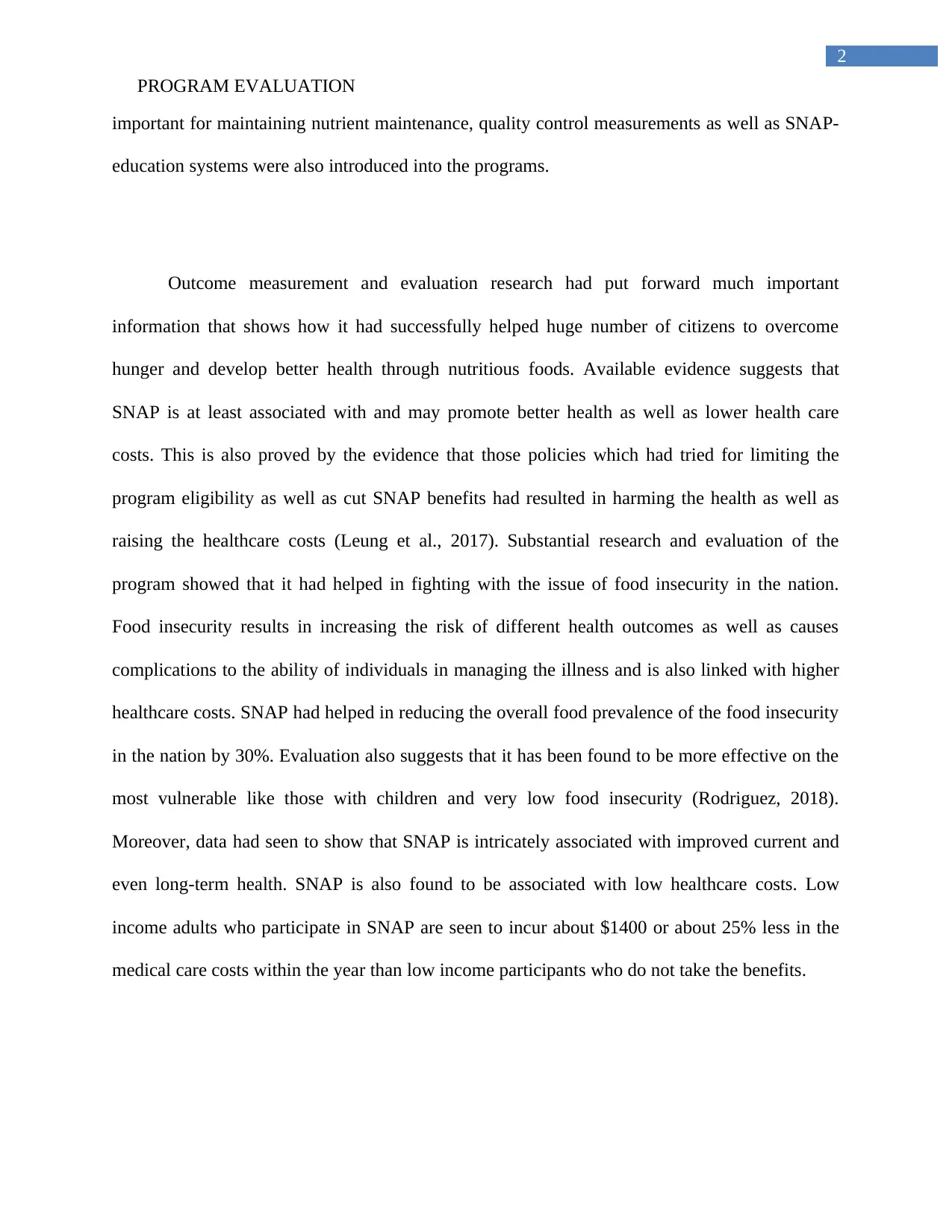
2
PROGRAM EVALUATION
important for maintaining nutrient maintenance, quality control measurements as well as SNAP-
education systems were also introduced into the programs.
Outcome measurement and evaluation research had put forward much important
information that shows how it had successfully helped huge number of citizens to overcome
hunger and develop better health through nutritious foods. Available evidence suggests that
SNAP is at least associated with and may promote better health as well as lower health care
costs. This is also proved by the evidence that those policies which had tried for limiting the
program eligibility as well as cut SNAP benefits had resulted in harming the health as well as
raising the healthcare costs (Leung et al., 2017). Substantial research and evaluation of the
program showed that it had helped in fighting with the issue of food insecurity in the nation.
Food insecurity results in increasing the risk of different health outcomes as well as causes
complications to the ability of individuals in managing the illness and is also linked with higher
healthcare costs. SNAP had helped in reducing the overall food prevalence of the food insecurity
in the nation by 30%. Evaluation also suggests that it has been found to be more effective on the
most vulnerable like those with children and very low food insecurity (Rodriguez, 2018).
Moreover, data had seen to show that SNAP is intricately associated with improved current and
even long-term health. SNAP is also found to be associated with low healthcare costs. Low
income adults who participate in SNAP are seen to incur about $1400 or about 25% less in the
medical care costs within the year than low income participants who do not take the benefits.
PROGRAM EVALUATION
important for maintaining nutrient maintenance, quality control measurements as well as SNAP-
education systems were also introduced into the programs.
Outcome measurement and evaluation research had put forward much important
information that shows how it had successfully helped huge number of citizens to overcome
hunger and develop better health through nutritious foods. Available evidence suggests that
SNAP is at least associated with and may promote better health as well as lower health care
costs. This is also proved by the evidence that those policies which had tried for limiting the
program eligibility as well as cut SNAP benefits had resulted in harming the health as well as
raising the healthcare costs (Leung et al., 2017). Substantial research and evaluation of the
program showed that it had helped in fighting with the issue of food insecurity in the nation.
Food insecurity results in increasing the risk of different health outcomes as well as causes
complications to the ability of individuals in managing the illness and is also linked with higher
healthcare costs. SNAP had helped in reducing the overall food prevalence of the food insecurity
in the nation by 30%. Evaluation also suggests that it has been found to be more effective on the
most vulnerable like those with children and very low food insecurity (Rodriguez, 2018).
Moreover, data had seen to show that SNAP is intricately associated with improved current and
even long-term health. SNAP is also found to be associated with low healthcare costs. Low
income adults who participate in SNAP are seen to incur about $1400 or about 25% less in the
medical care costs within the year than low income participants who do not take the benefits.
⊘ This is a preview!⊘
Do you want full access?
Subscribe today to unlock all pages.

Trusted by 1+ million students worldwide
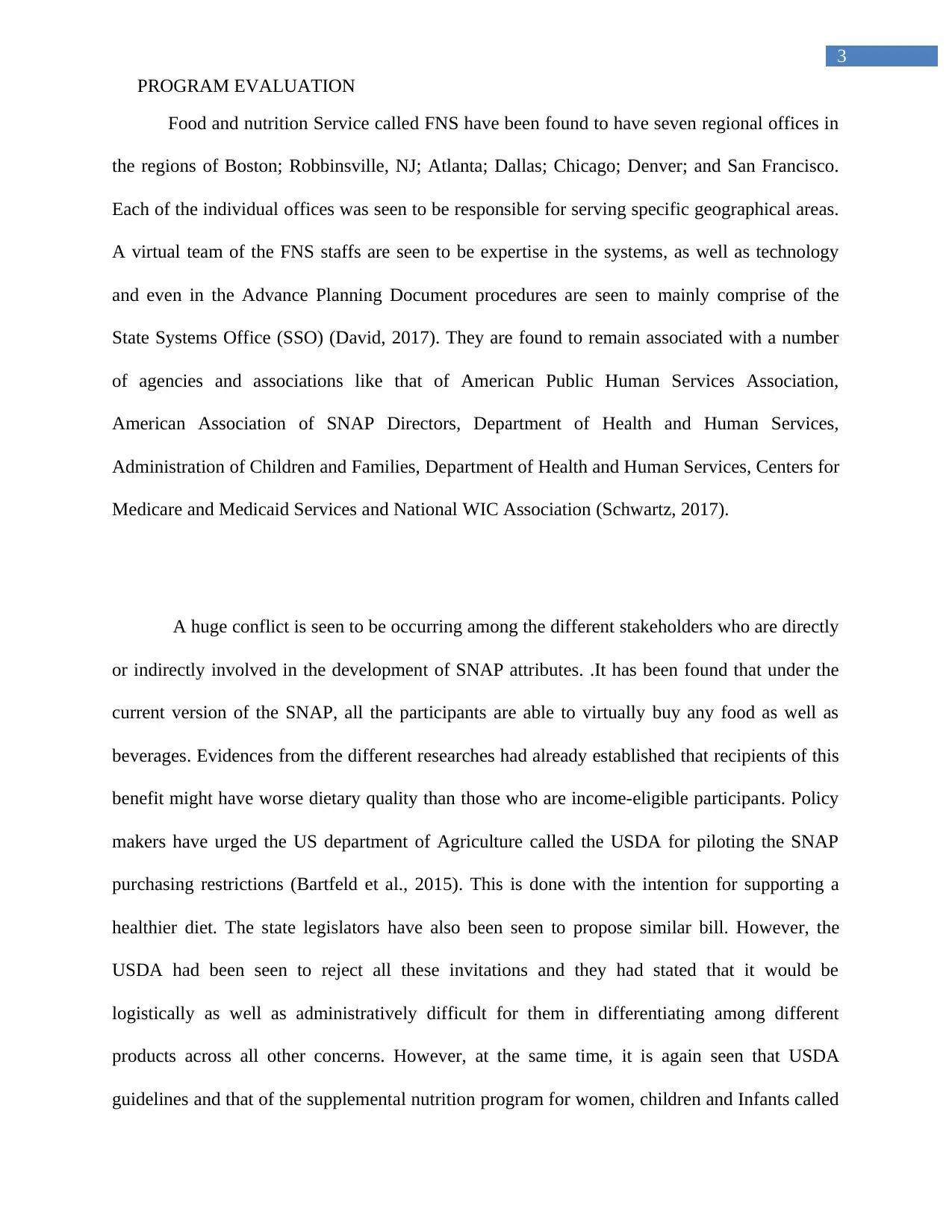
3
PROGRAM EVALUATION
Food and nutrition Service called FNS have been found to have seven regional offices in
the regions of Boston; Robbinsville, NJ; Atlanta; Dallas; Chicago; Denver; and San Francisco.
Each of the individual offices was seen to be responsible for serving specific geographical areas.
A virtual team of the FNS staffs are seen to be expertise in the systems, as well as technology
and even in the Advance Planning Document procedures are seen to mainly comprise of the
State Systems Office (SSO) (David, 2017). They are found to remain associated with a number
of agencies and associations like that of American Public Human Services Association,
American Association of SNAP Directors, Department of Health and Human Services,
Administration of Children and Families, Department of Health and Human Services, Centers for
Medicare and Medicaid Services and National WIC Association (Schwartz, 2017).
A huge conflict is seen to be occurring among the different stakeholders who are directly
or indirectly involved in the development of SNAP attributes. .It has been found that under the
current version of the SNAP, all the participants are able to virtually buy any food as well as
beverages. Evidences from the different researches had already established that recipients of this
benefit might have worse dietary quality than those who are income-eligible participants. Policy
makers have urged the US department of Agriculture called the USDA for piloting the SNAP
purchasing restrictions (Bartfeld et al., 2015). This is done with the intention for supporting a
healthier diet. The state legislators have also been seen to propose similar bill. However, the
USDA had been seen to reject all these invitations and they had stated that it would be
logistically as well as administratively difficult for them in differentiating among different
products across all other concerns. However, at the same time, it is again seen that USDA
guidelines and that of the supplemental nutrition program for women, children and Infants called
PROGRAM EVALUATION
Food and nutrition Service called FNS have been found to have seven regional offices in
the regions of Boston; Robbinsville, NJ; Atlanta; Dallas; Chicago; Denver; and San Francisco.
Each of the individual offices was seen to be responsible for serving specific geographical areas.
A virtual team of the FNS staffs are seen to be expertise in the systems, as well as technology
and even in the Advance Planning Document procedures are seen to mainly comprise of the
State Systems Office (SSO) (David, 2017). They are found to remain associated with a number
of agencies and associations like that of American Public Human Services Association,
American Association of SNAP Directors, Department of Health and Human Services,
Administration of Children and Families, Department of Health and Human Services, Centers for
Medicare and Medicaid Services and National WIC Association (Schwartz, 2017).
A huge conflict is seen to be occurring among the different stakeholders who are directly
or indirectly involved in the development of SNAP attributes. .It has been found that under the
current version of the SNAP, all the participants are able to virtually buy any food as well as
beverages. Evidences from the different researches had already established that recipients of this
benefit might have worse dietary quality than those who are income-eligible participants. Policy
makers have urged the US department of Agriculture called the USDA for piloting the SNAP
purchasing restrictions (Bartfeld et al., 2015). This is done with the intention for supporting a
healthier diet. The state legislators have also been seen to propose similar bill. However, the
USDA had been seen to reject all these invitations and they had stated that it would be
logistically as well as administratively difficult for them in differentiating among different
products across all other concerns. However, at the same time, it is again seen that USDA
guidelines and that of the supplemental nutrition program for women, children and Infants called
Paraphrase This Document
Need a fresh take? Get an instant paraphrase of this document with our AI Paraphraser
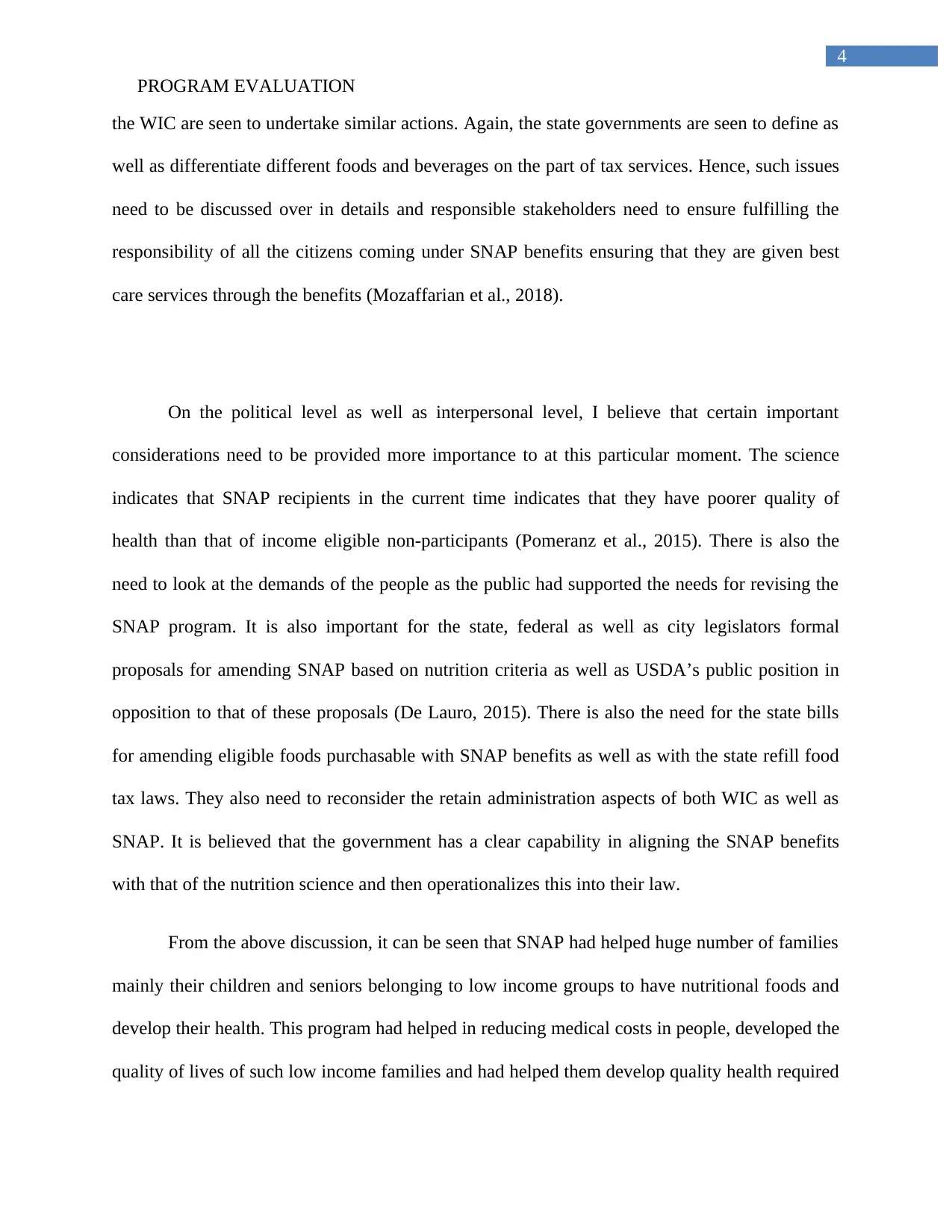
4
PROGRAM EVALUATION
the WIC are seen to undertake similar actions. Again, the state governments are seen to define as
well as differentiate different foods and beverages on the part of tax services. Hence, such issues
need to be discussed over in details and responsible stakeholders need to ensure fulfilling the
responsibility of all the citizens coming under SNAP benefits ensuring that they are given best
care services through the benefits (Mozaffarian et al., 2018).
On the political level as well as interpersonal level, I believe that certain important
considerations need to be provided more importance to at this particular moment. The science
indicates that SNAP recipients in the current time indicates that they have poorer quality of
health than that of income eligible non-participants (Pomeranz et al., 2015). There is also the
need to look at the demands of the people as the public had supported the needs for revising the
SNAP program. It is also important for the state, federal as well as city legislators formal
proposals for amending SNAP based on nutrition criteria as well as USDA’s public position in
opposition to that of these proposals (De Lauro, 2015). There is also the need for the state bills
for amending eligible foods purchasable with SNAP benefits as well as with the state refill food
tax laws. They also need to reconsider the retain administration aspects of both WIC as well as
SNAP. It is believed that the government has a clear capability in aligning the SNAP benefits
with that of the nutrition science and then operationalizes this into their law.
From the above discussion, it can be seen that SNAP had helped huge number of families
mainly their children and seniors belonging to low income groups to have nutritional foods and
develop their health. This program had helped in reducing medical costs in people, developed the
quality of lives of such low income families and had helped them develop quality health required
PROGRAM EVALUATION
the WIC are seen to undertake similar actions. Again, the state governments are seen to define as
well as differentiate different foods and beverages on the part of tax services. Hence, such issues
need to be discussed over in details and responsible stakeholders need to ensure fulfilling the
responsibility of all the citizens coming under SNAP benefits ensuring that they are given best
care services through the benefits (Mozaffarian et al., 2018).
On the political level as well as interpersonal level, I believe that certain important
considerations need to be provided more importance to at this particular moment. The science
indicates that SNAP recipients in the current time indicates that they have poorer quality of
health than that of income eligible non-participants (Pomeranz et al., 2015). There is also the
need to look at the demands of the people as the public had supported the needs for revising the
SNAP program. It is also important for the state, federal as well as city legislators formal
proposals for amending SNAP based on nutrition criteria as well as USDA’s public position in
opposition to that of these proposals (De Lauro, 2015). There is also the need for the state bills
for amending eligible foods purchasable with SNAP benefits as well as with the state refill food
tax laws. They also need to reconsider the retain administration aspects of both WIC as well as
SNAP. It is believed that the government has a clear capability in aligning the SNAP benefits
with that of the nutrition science and then operationalizes this into their law.
From the above discussion, it can be seen that SNAP had helped huge number of families
mainly their children and seniors belonging to low income groups to have nutritional foods and
develop their health. This program had helped in reducing medical costs in people, developed the
quality of lives of such low income families and had helped them develop quality health required
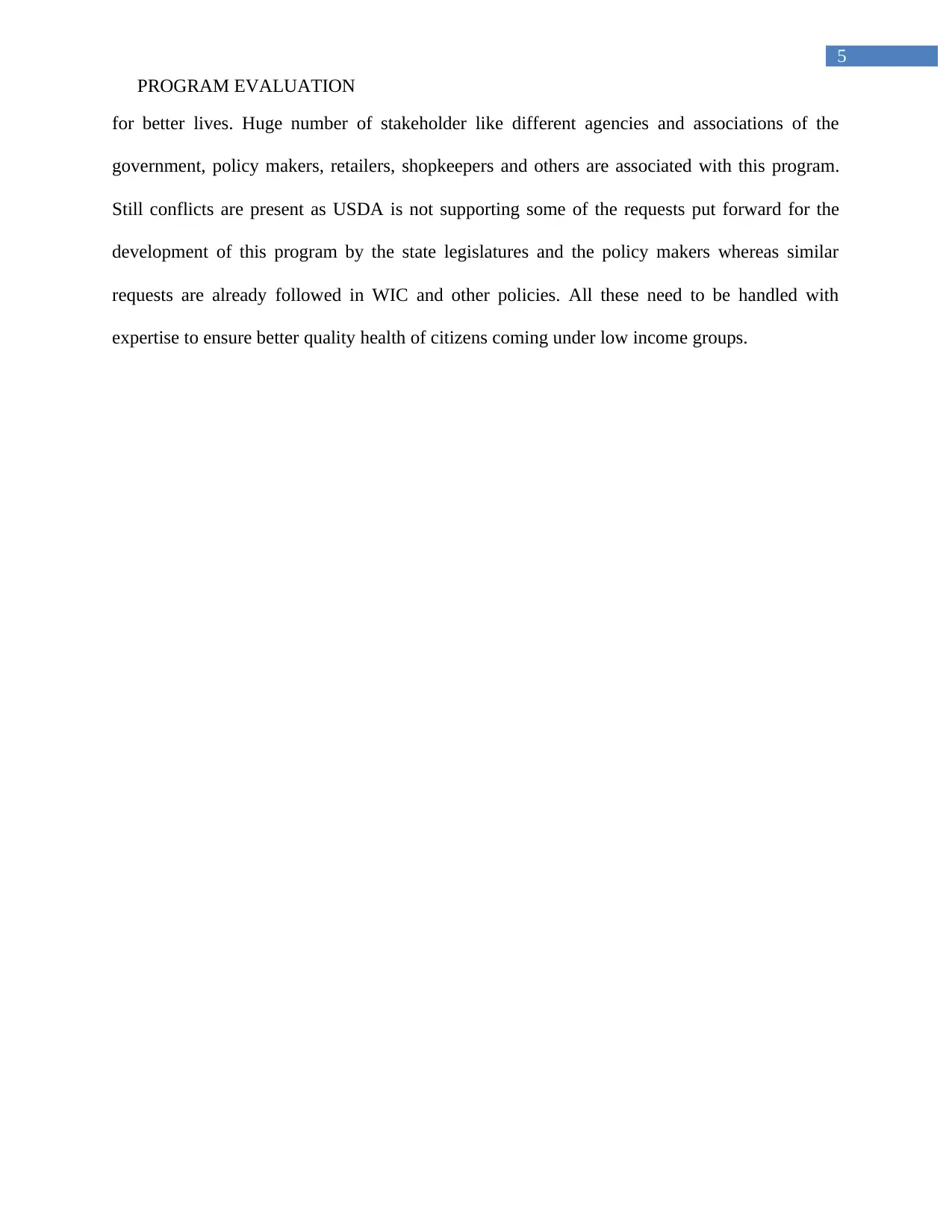
5
PROGRAM EVALUATION
for better lives. Huge number of stakeholder like different agencies and associations of the
government, policy makers, retailers, shopkeepers and others are associated with this program.
Still conflicts are present as USDA is not supporting some of the requests put forward for the
development of this program by the state legislatures and the policy makers whereas similar
requests are already followed in WIC and other policies. All these need to be handled with
expertise to ensure better quality health of citizens coming under low income groups.
PROGRAM EVALUATION
for better lives. Huge number of stakeholder like different agencies and associations of the
government, policy makers, retailers, shopkeepers and others are associated with this program.
Still conflicts are present as USDA is not supporting some of the requests put forward for the
development of this program by the state legislatures and the policy makers whereas similar
requests are already followed in WIC and other policies. All these need to be handled with
expertise to ensure better quality health of citizens coming under low income groups.
⊘ This is a preview!⊘
Do you want full access?
Subscribe today to unlock all pages.

Trusted by 1+ million students worldwide
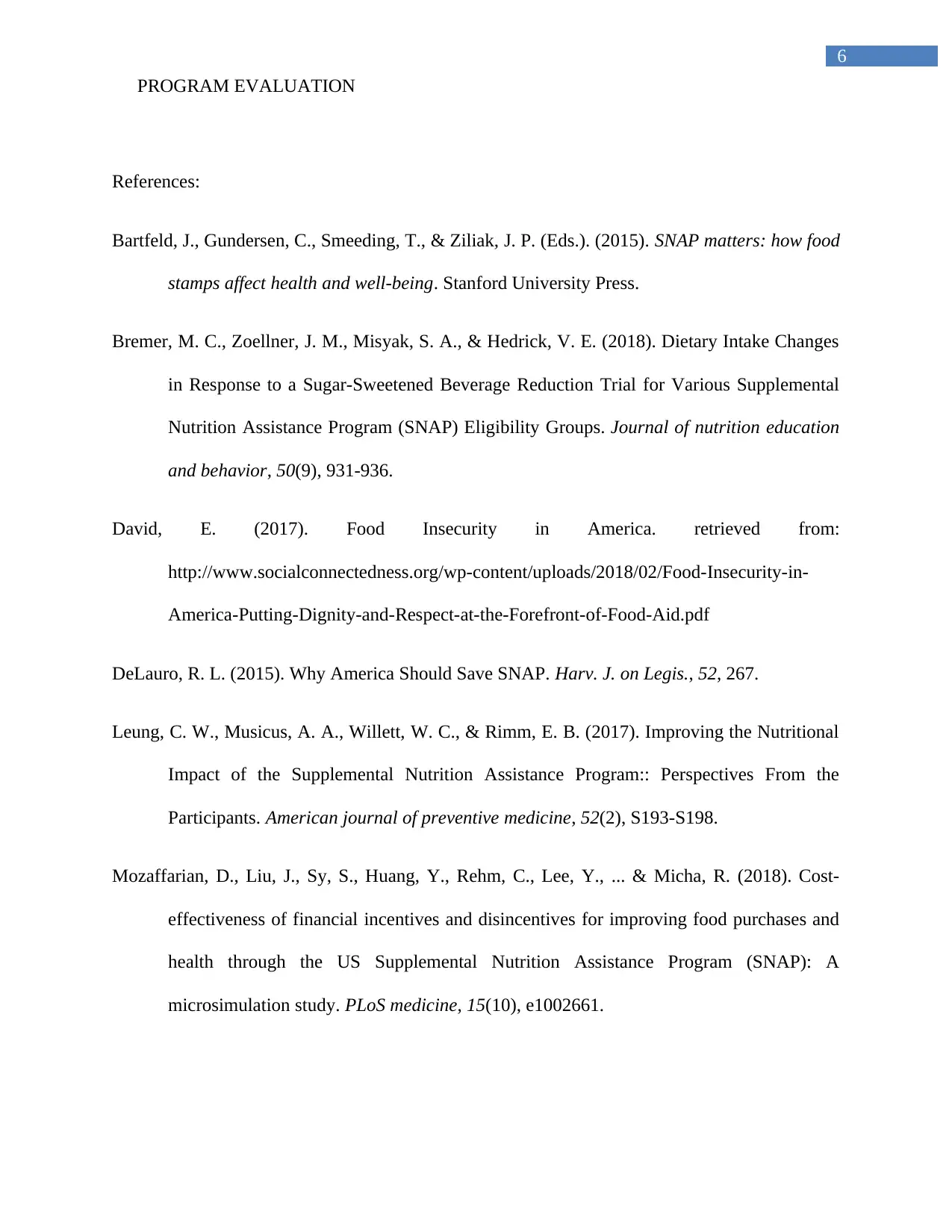
6
PROGRAM EVALUATION
References:
Bartfeld, J., Gundersen, C., Smeeding, T., & Ziliak, J. P. (Eds.). (2015). SNAP matters: how food
stamps affect health and well-being. Stanford University Press.
Bremer, M. C., Zoellner, J. M., Misyak, S. A., & Hedrick, V. E. (2018). Dietary Intake Changes
in Response to a Sugar-Sweetened Beverage Reduction Trial for Various Supplemental
Nutrition Assistance Program (SNAP) Eligibility Groups. Journal of nutrition education
and behavior, 50(9), 931-936.
David, E. (2017). Food Insecurity in America. retrieved from:
http://www.socialconnectedness.org/wp-content/uploads/2018/02/Food-Insecurity-in-
America-Putting-Dignity-and-Respect-at-the-Forefront-of-Food-Aid.pdf
DeLauro, R. L. (2015). Why America Should Save SNAP. Harv. J. on Legis., 52, 267.
Leung, C. W., Musicus, A. A., Willett, W. C., & Rimm, E. B. (2017). Improving the Nutritional
Impact of the Supplemental Nutrition Assistance Program:: Perspectives From the
Participants. American journal of preventive medicine, 52(2), S193-S198.
Mozaffarian, D., Liu, J., Sy, S., Huang, Y., Rehm, C., Lee, Y., ... & Micha, R. (2018). Cost-
effectiveness of financial incentives and disincentives for improving food purchases and
health through the US Supplemental Nutrition Assistance Program (SNAP): A
microsimulation study. PLoS medicine, 15(10), e1002661.
PROGRAM EVALUATION
References:
Bartfeld, J., Gundersen, C., Smeeding, T., & Ziliak, J. P. (Eds.). (2015). SNAP matters: how food
stamps affect health and well-being. Stanford University Press.
Bremer, M. C., Zoellner, J. M., Misyak, S. A., & Hedrick, V. E. (2018). Dietary Intake Changes
in Response to a Sugar-Sweetened Beverage Reduction Trial for Various Supplemental
Nutrition Assistance Program (SNAP) Eligibility Groups. Journal of nutrition education
and behavior, 50(9), 931-936.
David, E. (2017). Food Insecurity in America. retrieved from:
http://www.socialconnectedness.org/wp-content/uploads/2018/02/Food-Insecurity-in-
America-Putting-Dignity-and-Respect-at-the-Forefront-of-Food-Aid.pdf
DeLauro, R. L. (2015). Why America Should Save SNAP. Harv. J. on Legis., 52, 267.
Leung, C. W., Musicus, A. A., Willett, W. C., & Rimm, E. B. (2017). Improving the Nutritional
Impact of the Supplemental Nutrition Assistance Program:: Perspectives From the
Participants. American journal of preventive medicine, 52(2), S193-S198.
Mozaffarian, D., Liu, J., Sy, S., Huang, Y., Rehm, C., Lee, Y., ... & Micha, R. (2018). Cost-
effectiveness of financial incentives and disincentives for improving food purchases and
health through the US Supplemental Nutrition Assistance Program (SNAP): A
microsimulation study. PLoS medicine, 15(10), e1002661.
Paraphrase This Document
Need a fresh take? Get an instant paraphrase of this document with our AI Paraphraser
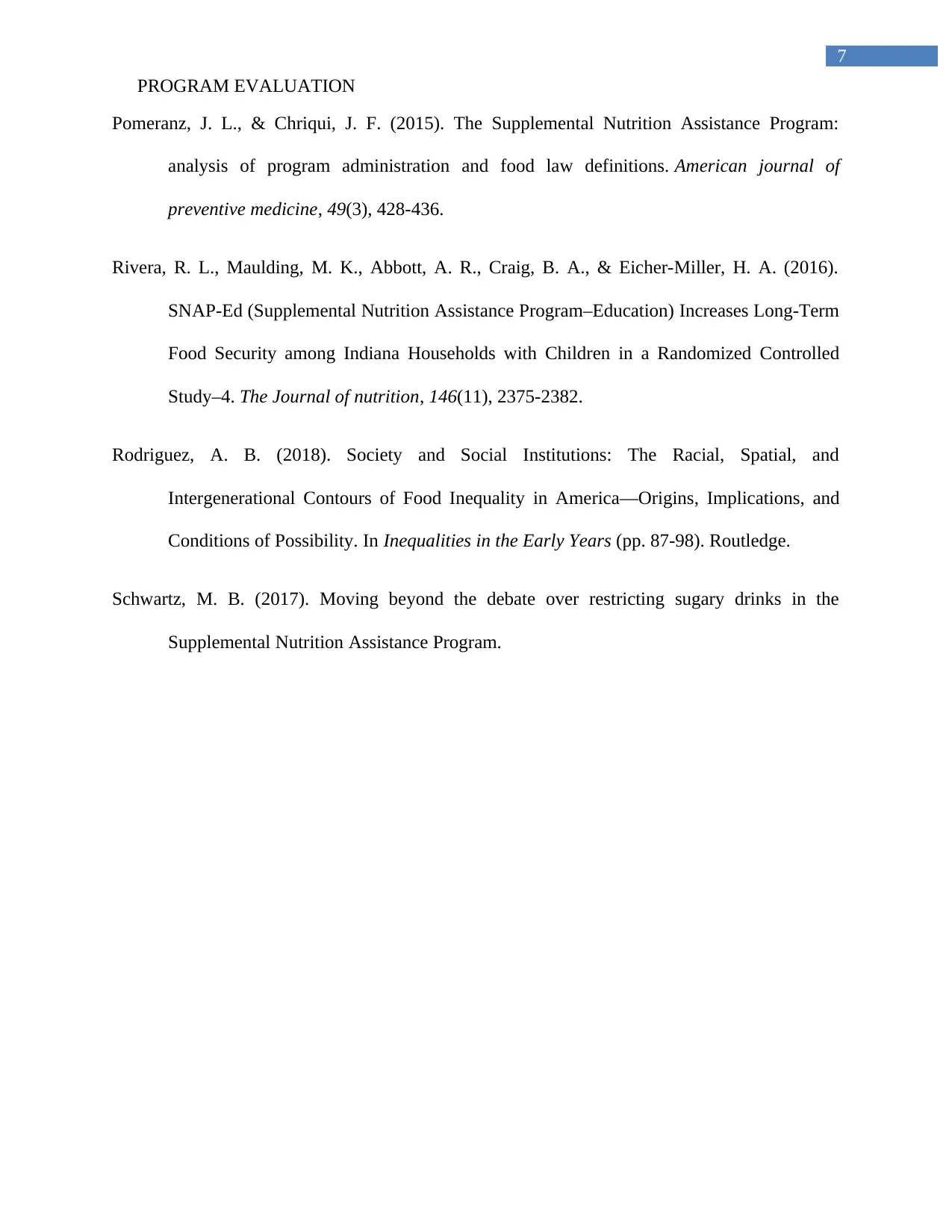
7
PROGRAM EVALUATION
Pomeranz, J. L., & Chriqui, J. F. (2015). The Supplemental Nutrition Assistance Program:
analysis of program administration and food law definitions. American journal of
preventive medicine, 49(3), 428-436.
Rivera, R. L., Maulding, M. K., Abbott, A. R., Craig, B. A., & Eicher-Miller, H. A. (2016).
SNAP-Ed (Supplemental Nutrition Assistance Program–Education) Increases Long-Term
Food Security among Indiana Households with Children in a Randomized Controlled
Study–4. The Journal of nutrition, 146(11), 2375-2382.
Rodriguez, A. B. (2018). Society and Social Institutions: The Racial, Spatial, and
Intergenerational Contours of Food Inequality in America—Origins, Implications, and
Conditions of Possibility. In Inequalities in the Early Years (pp. 87-98). Routledge.
Schwartz, M. B. (2017). Moving beyond the debate over restricting sugary drinks in the
Supplemental Nutrition Assistance Program.
PROGRAM EVALUATION
Pomeranz, J. L., & Chriqui, J. F. (2015). The Supplemental Nutrition Assistance Program:
analysis of program administration and food law definitions. American journal of
preventive medicine, 49(3), 428-436.
Rivera, R. L., Maulding, M. K., Abbott, A. R., Craig, B. A., & Eicher-Miller, H. A. (2016).
SNAP-Ed (Supplemental Nutrition Assistance Program–Education) Increases Long-Term
Food Security among Indiana Households with Children in a Randomized Controlled
Study–4. The Journal of nutrition, 146(11), 2375-2382.
Rodriguez, A. B. (2018). Society and Social Institutions: The Racial, Spatial, and
Intergenerational Contours of Food Inequality in America—Origins, Implications, and
Conditions of Possibility. In Inequalities in the Early Years (pp. 87-98). Routledge.
Schwartz, M. B. (2017). Moving beyond the debate over restricting sugary drinks in the
Supplemental Nutrition Assistance Program.
1 out of 8
Related Documents
Your All-in-One AI-Powered Toolkit for Academic Success.
+13062052269
info@desklib.com
Available 24*7 on WhatsApp / Email
![[object Object]](/_next/static/media/star-bottom.7253800d.svg)
Unlock your academic potential
Copyright © 2020–2025 A2Z Services. All Rights Reserved. Developed and managed by ZUCOL.





